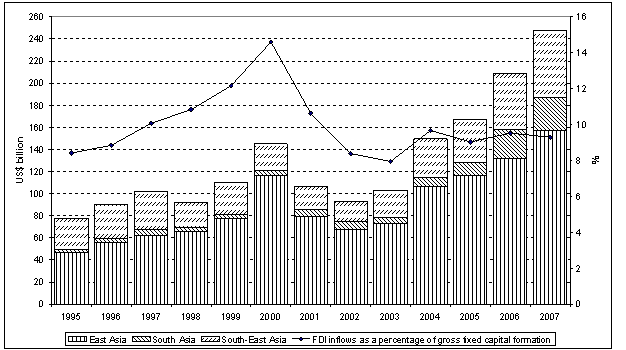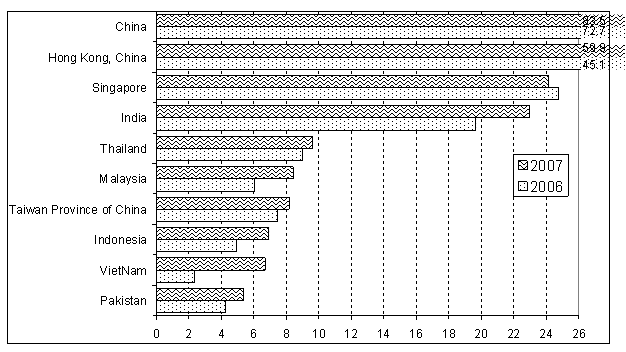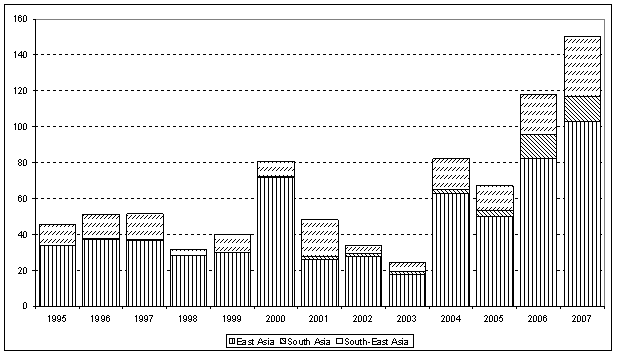| EMBARGO The contents of this press release and the related Report must not be quoted or summarized in the print, broadcast or electronic media before 24 September 2008, 17:00 GMT (13:00 New York, 19:00 Geneva, 22:30 New Delhi, 02:00 - 25 September in Tokyo) |
Geneva, 24 September 2008 - South, East, South-East Asia, and Oceania together remained the largest recipient of foreign direct investment (FDI) among all developing regions and transition economies in 2007, according to this year´s World Investment Report(1) . The region accounted for two fifths of such flows.
The 2008 edition of UNCTAD´s annual investment review, subtitled "Transnational Corporations and the Infrastructure Challenge", was released today.
FDI inflows to the region rose to yet another record in 2007, reaching US$ 249 billion - a 18% increase over 2006 (figure I). Contributing to this robust growth were significant cross-border mergers and acquisitions (M&As), amounting to almost US$ 82 billion - an increase of 33% - and general improvements in the investment environment. These improvements included further liberalization of FDI, strengthened regional economic integration, resilient economic growth, and strong industrial development.
China and Hong Kong (China) remained the two largest FDI recipients in the region as well as among all developing countries. Flows to India - the largest recipient in South Asia - and to most member States of the Association of Southeast Asian Nations (ASEAN) increased considerably (figure 2). Post-conflict countries and Asian least developed countries (LDCs), such as Afghanistan, Cambodia, Sri Lanka and Timor-Leste, also attracted higher inflows.
Outflows from the region in 2007 surged to US$ 150 billion - their highest level ever (figure 3) - and accounted for the bulk of outward investment from developing countries (59%). Contributing to the increase was a 57% jump in cross-border acquisitions by firms from the region, to US$ 89 billion. These transactions occurred particularly in finance and other service activities, electronics, and the extractive industries. More Asian firms are engaging in international production for various reasons, including to build or acquire brand names and technology, and to harvest natural resources.
The region is also home to a growing number of large sovereign wealth funds (SWFs), reflecting the rapidly rising foreign exchange reserves and proactive government policies of some countries. These funds have contributed to the region´s rapidly growing outward FDI stock. Outflows from Hong Kong (China) - the largest source of FDI from the developing world - rose significantly, to US$ 53 billion in 2007, more than twice the outflows from China, which increased by 6% to US$ 22 billion. Investment from South Asia reached US$ 14.2 billion (a 6% increase), dominated by investments from India, which rose to US$ 13.6 billion in 2007 (figure III). A 51% increase in outward FDI from ASEAN nations, to US$ 33 billion, was dominated by investments from Singapore. Malaysia is also emerging as a significant ASEAN investor.
Changes in national policies related to FDI were largely favourable for investors. Some governments in the region further relaxed ownership restrictions on foreign investors, encouraged private-sector investment in infrastructure industries, and introduced a variety of measures to attract FDI. Some countries, for instance, increased the level of investment protection provided under their investment laws or relaxed foreign-exchange controls, improved admission procedures, and offered investment incentives. A number of new measures aimed at encouraging or supporting outward FDI were also launched in 2007. For example, China, India, the Republic of Korea, and Thailand introduced or adopted outward FDI policies and regulations.
Prospects for FDI inflows to the region remain promising despite concerns about the impact of the financial crisis triggered by problems in the sub-prime mortgage market in the United States. All factors contributing to the region´s FDI performance in 2007 are expected to continue to attract inflows over the near future. Outward FDI is likely to grow even more as Asian firms are increasingly aspiring to become significant regional ? and global ? players in their respective industries -- particularly in telecommunications, finance, and manufacturing.
The World Investment Report and its database are available online at http://www.unctad.org/wir and http://www.unctad.org/fdistatistics |
ANNEX
Tables and figures
Figure 1. South, East and South-Est Asia: FDI inflows in value and as a percentage of gross fixed capital formation, 1995-2007
Source:UNCTAD, World Investment Report 2008: Transnational Corporations and the infrastructure Challenge
Figure 2. South, East and South-Est Asia: top 10 recipients of FDI inflows, a 2006-2007(Billions of US dollars)
Source:UNCTAD, World Investment Report 2008: Transnational Corporations and the infrastructure Challenge
Note:a- Ranked by magnitude of 2007 FDI inflows
Figure 3. South, East and South-Est Asia: FDI outflows, 1995-2007(Billions of US dollars)
Source:UNCTAD, World Investment Report 2008: Transnational Corporations and the infrastructure Challenge


